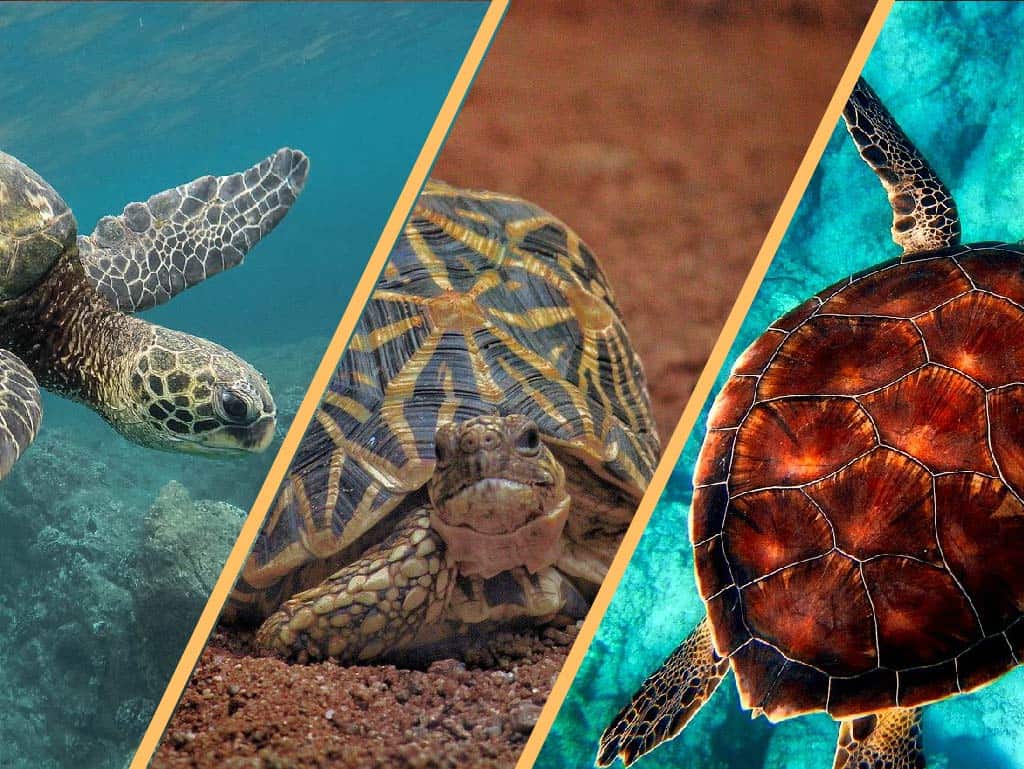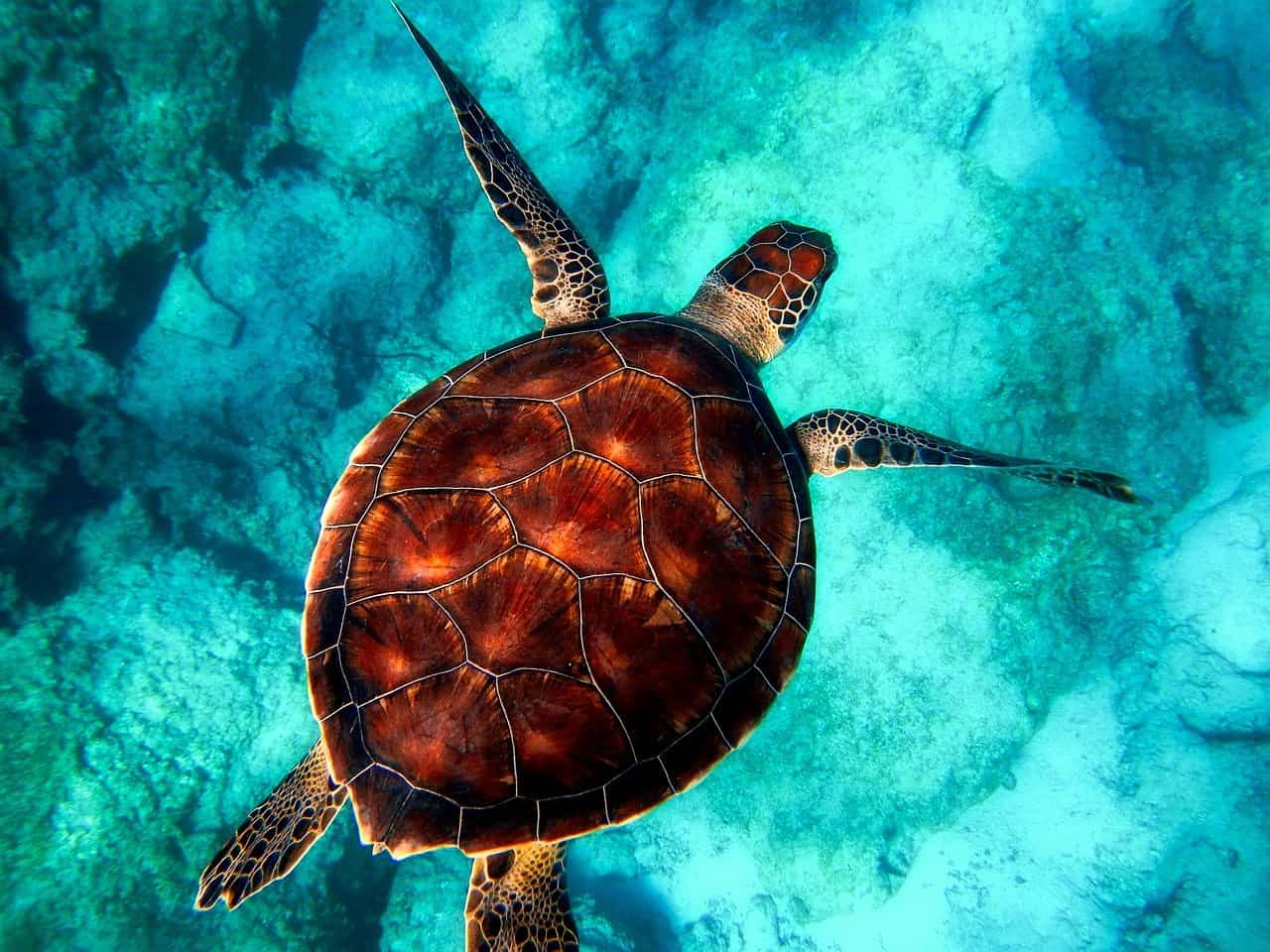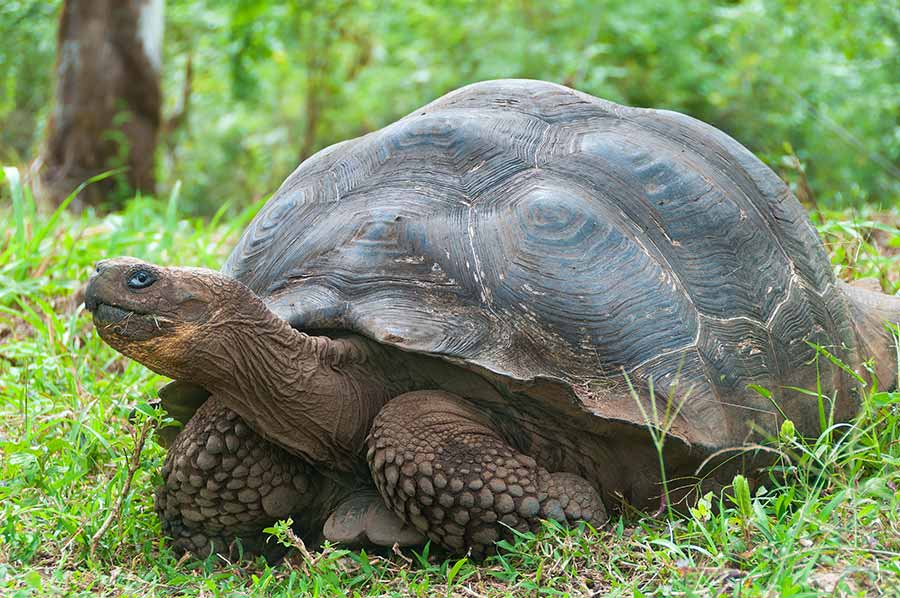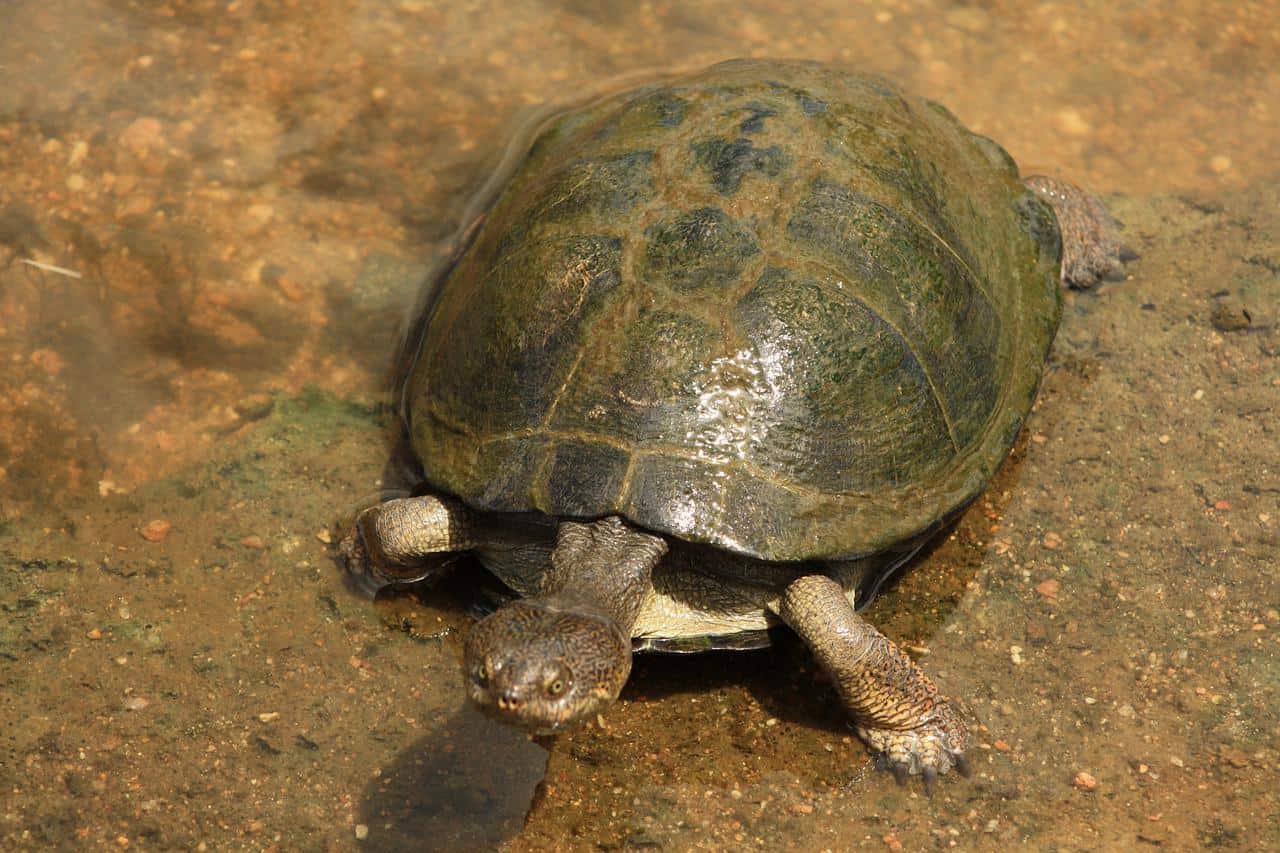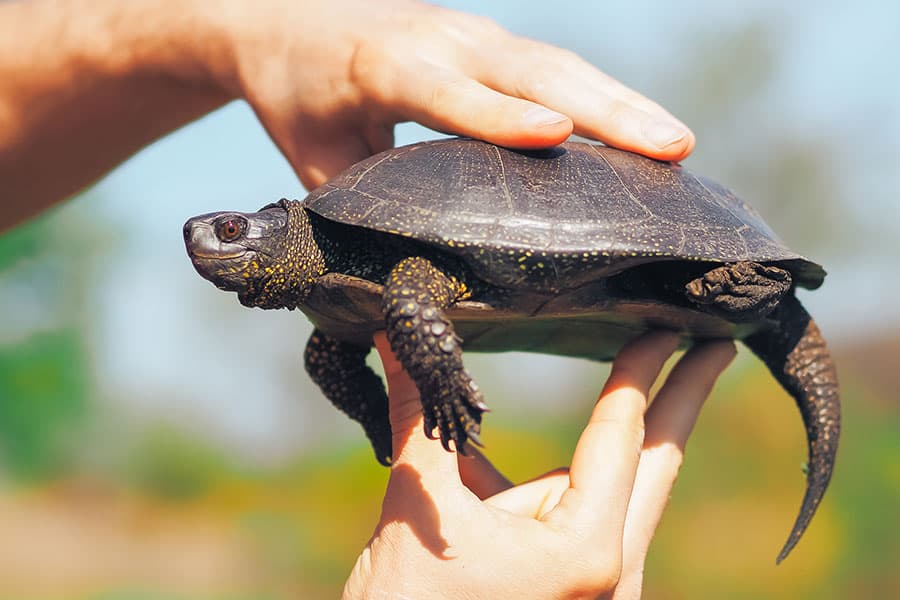What are the main differences between turtles vs tortoises vs terrapins?
Turtles, tortoises, and terrapins all belong to the same reptilian family of chelonians. Chelonians make up all of the shelled animals in the reptile class. This means turtles, tortoises, and terrapins are all related!
However, there are some key differences between the three groups of chelonians, and these differences are what make them distinct from one another.
Most notably, tortoises, terrapins, and turtles all live in different environments and eat different foods. These environments have helped encourage these animals to evolve, so their bodies have adapted differently to help them survive in their unique situations.
Keep reading to find out what these adaptations are and how you can tell them apart!
Main Differences Between Turtles vs Tortoises vs Terrapins
The main differences between turtles vs tortoises vs terrapins are:
- Turtles are mostly aquatic, whereas terrapins are semi-aquatic and tortoises are completely terrestrial.
- Turtles and terrapins are omnivores, whereas tortoises are strictly herbivores.
- Terrapins live a relatively short life of 20 to 40 years, whereas turtles live a much longer life of 60 to 70 years, whereas tortoises live extremely long lives of 100+ years.
- Turtles have flat flippers, whereas terrapins have webbed feet with sharp claws and tortoises have more stout, bulky legs tipped with short nails.
- Turtles are not able to fully retract into their flattened shells, whereas terrapins only have a slightly flattened shell and can retract their heads but not all of their limbs in, whereas tortoises can fully retract their bodies into their domed shells.
Turtles, terrapins, and tortoises may all look fairly similar and belong to the same family, but as you can see, there are some key differences between them. Due to their physical differences, some are easier to care for, while others can be incredibly difficult and should not be kept in captivity at all.
Turtles vs Tortoises vs Terrapins: Overview
Turtles are the original blueprint for chelonians. All tortoises and terrapins are, in fact, actually turtles! All tortoises and terrapins are turtles, but not all turtles are tortoises or terrapins!
I know this is a bit confusing at first, but not to worry; this article is all about distinguishing these groups from one another. They have all evolved differently and developed unique traits that help them live in their natural environments.
Turtles
“Turtles” as most of us know are the adorable shelled, ocean-dwelling creatures featured in Finding Nemo! These reptiles have large shells that help protect their organs while they cut through the water and race against the tides.
Some of the most well-known turtle species include the leatherback turtle, the green sea turtle, and the hawksbill sea turtle.
Tortoises
Tortoises are land-dwelling reptiles that are strict herbivores and love a good carrot to munch on every now and then. Tortoises are what we are most familiar with in terms of looks with large, domed shells and stubby yet bulky legs.
Some of the most well-known tortoise species include sulcata tortoises, Russian tortoises, and leopard tortoises. They do best in warm, fairly dry habitats compared to turtles and terrapins.
Terrapins
Terrapins are smaller-bodied turtles that are strong swimmers and live in fresh to brackish water. Their habitats tend to be warm to temperate forested areas with rivers, ponds, and creeks nearby.
The term “terrapin” comes from “torope,” which is the Native American Algonquian word for “little turtle.” Terrapins are also known as sliders in the US.
The most well-known terrapin species include the yellow-bellied slider and the red-eared slider. Did you know the red-eared slider was the inspiration for the Teenage Mutant Ninja Turtles?
Turtles vs Tortoises vs Terrapins: Where Do They Live?
The environment of an animal is important to consider when you are looking for differences in their physical appearance, their biology, or their behavior.
In the case of turtles vs terrapins vs tortoises, it is of key importance to understand how their environments affects them directly and trigger certain evolutionary changes over time.
Turtles Are Aquatic
Turtles are nearly 100% aquatic. They live in very large bodies of saltwater such as seas and oceans. They breathe air like other reptiles, though, so they do need to come to the surface often to breathe.
Turtles’ aquatic lifestyle means they live their entire lives in the water. They live, eat, mate, travel, and die in the water. The only time they leave the safety of the water for dry land is to make their way onto beaches to dig nests and lay their eggs. Many baby turtles must complete a long and arduous trek from the beach to the water upon hatching!
Terrapins Are Semi-Aquatic
Terrapins are semi-aquatic creatures. They live in smaller bodies of water such as ponds, rivers, and estuaries that are fresh or “brackish.” Brackish or briny water has some salt content but is not salty enough for oceanic animals to live in it.
Terrapins live most of their lives in the water. However, they will leave the water and move across dry land from time to time to find another water source or climb onto rocks or logs in order to bask in the sun and dry out their shells.
Tortoises Are Terrestrial
Tortoises are land-dwelling animals. This means they cannot swim and will drown if placed in water that is too deep for them to stand in and raise their heads. Tortoises are large, hardy, heavy-bodied reptiles that can be found in many different biomes and habitats such as savannahs, mountain ranges, and jungles.
Tortoises will often wade through some shallow water or mud in order to bathe or drink; however, they will never venture into water that goes past their knees.
What Does This Difference in Environment Mean?
The differences between these animals’ environments have caused each of these animals to have different adaptations that allow them to live in their environment successfully.
In captivity, for any of them to survive, they must be housed in a comfortable, spacious enclosure designed to closely replicate their natural habitat.
What do They Eat?
Different animals have different dietary needs due to the size, shape, and construction of their digestive systems. A shorter, straighter digestive system is suited to a diet that has large amounts of animal protein in it, whereas a longer, folded digestive system is needed to digest the tough cellulose found in plants.
Turtles and Terrapins Are Omnivores
Turtles and terrapins are both omnivores, which means they eat a combination of plant matter and animal protein. This is a very varied diet that mostly depends on what can be found in a specific turtle or terrapin’s environment.
Younger turtles and terrapins will eat a lot more protein than older turtles and terrapins because they are growing and need the nutrition from animal products in order to build strong muscles, joints, and bones.
As turtles and terrapins get older, they move to a more plant-based diet because they are no longer actively building their bodies but rather simply maintaining them.
Tortoises Are Herbivores
Tortoises on the other hand, are strict herbivores. They need large amounts of vegetation daily in order to grow and maintain their bodies. The larger the tortoise is, the more food they need.
Tortoises need a varied diet, too. They get different nutrients from different plants, and this should be reflected in their captive diet, too. Feeding a pet tortoise lots of colorful vegetables and greens is a fun task because you will get to see exactly how voracious their appetites are.
What Does This Difference in Diet Mean?
These animals’ natural diets should be replicated, or come close to it, in captivity. If a tortoise is fed animal protein, for example, they can get very sick due to their digestive systems not being designed to digest it properly. In a similar way, if a turtle or terrapin is only fed on plant matter or animal products, they will suffer from nutritional deficiencies.
How Long Do They Live?
Turtles, terrapins, and tortoises all live for a very long time. Many varieties live so long that they will usually outlive their original owners! They are slow-growing animals that can live anywhere from 20 to more than 80 years depending on the exact species.
Turtles
Most turtles live for around 70 to 80 years on average in the wild. However, there are some extreme cases on both ends of the spectrum. Life in the ocean can be very brutal, especially early on in life, but thankfully, turtles tend to avoid the drama and beat the odds when faced with their natural predators by adapting and maturing quickly and laying very large clutches of eggs at a time.
Unfortunately, their lifespans are still being seriously affected by climate change. The warming of the oceans is killing off the coral many turtles rely on, and the changing of ocean currents is bringing new predators their way that they have not yet adapted to surviving. All of these factors are contributing to shorter lifespans amongst ocean-dwelling turtles.
Terrapins
Terrapins are relatively short-lived when compared with their fellow chelonians. Most species, such as the popular red-eared slider, live for 20 to 40 years on average. However, with excellent care from the time they are babies, they can live for an additional decade or two in captivity!
Tortoises
Tortoises are truly magnificent animals when considering their age. Their average age is 80 years old, and they frequently exceed 100 years! Small and large tortoises can all reach extreme ages when cared for properly.
The reason some tortoises do not reach their maximum possible age in captivity is often poor care or poor nutrition. Tortoises need specialized care, additional diet supplements, and large, enriching spaces to roam, which can be challenging to maintain and sometimes end up neglected by their owners.
What Does This Difference in Lifespan Mean?
Lifespan is a huge factor to keep in mind when considering owning a turtle, terrapin, or tortoise. They are all long-term commitments (often lifetime commitments, in fact!), and they still need to be taken care of if they end up outliving their owners.
Poor husbandry often reduces the lifespan of captive turtles, terrapins, and tortoises by causing stunted growth, poor organ development, and stress, which all lead to death at a premature age. They are challenging yet extremely rewarding pets when their needs are consistently met.
Foot Anatomy
As we’ve touched on throughout this article, turtles, terrapins, and tortoises have all evolved over time to be better suited to the particular environment they live in. This means every part of their bodies, including their limbs, are specially shaped to help them move through their natural environment with ease.
Most chelonians’ limbs are either long flippers or short, stocky feet depending on their habitat.
Turtles
Turtles do not have feet. Instead, they have flippers that help propel them through the water. Their front flippers are very large and strong. They are designed to pull their heavy bodies through the ocean’s rough currents. Their back flippers are smaller and are designed to help steer them in the right direction.
When turtles go up onto beaches to lay their eggs, they first need to dig a nest. They do this with their strong front flippers! Their flippers are not the most graceful digging tools, but they get the job done.
Terrapins
Terrapins have the best of both worlds. They have stout little legs that are slightly flattened with webbed toes! The webbing between their toes helps them to move through the water. The brackish and freshwater bodies they live in do not have strong currents like the ocean, which is why they do not need huge flippers like turtles.
Each toe is tipped with a claw. These claws help terrapins climb onto logs and rocks in order to sun themselves or to move between different water sources.
Tortoises
Tortoises have large, strong, bulky legs that stick out sort of perpendicularly to their bodies. These legs are strong enough to lift their entire bodies off of the ground to move around.
Their legs are often covered with large, rough scales and are tipped with little toenail-looking scales. Tortoises’ limbs are perfectly equipped for traversing a range of terrestrial habitats, from bumpy, rocky outcrops to flatter savannahs and grasslands.
What Does This Difference in Limb Structure Mean?
The differences in the ways each of these animals’ limbs are structured determine how well they are able to move through their environments. A terrapin, for example, would struggle to survive in a very large body of water that has a strong current, a turtle would not move very quickly on land, and a tortoise would not be able to swim in the ocean!
Differences in Shell Structure
Just like with their limbs, each of these chelonians’ shells is specially adapted to suit their environment and help them live long healthy lives. While their shells look similar at a glance, they differ in a few key ways.
Turtles
Turtles generally have flat, oval-shaped shells. This shape helps them cut through the ocean water with ease. Their flattened shells create less drag than a domed shell would. This means they can travel much faster and further while using less energy.
However, with the flattening of their shells, they do not have space to retract their heads and flippers inside it when danger rears its head. Fortunately, this is where their speed comes into play. Turtles are able to move quickly through the ocean waters to get away from predators.
Terrapins
Terrapins have slightly flattened round shells. This unique shell shape and structure helps them move through the water fairly quickly. However, speed is not their main goal. Terrapins have large enough shells that they can still retract their heads into them, but most of their legs remain exposed.
Their strategy when faced with an aquatic predator is to get to dry land as quickly as possible!
Tortoises
Tortoise shells are fairly tall, dense, and round. Their shells are structured this way to provide them with the best possible armor in times of attack.
The carapace (top of the shell) is domed, which provides them with space and a protective casing for their bodies, limbs, and internal organs. The plastron (bottom of the shell) is flat, so there is nothing to catch on the shell when the tortoise is walking around on land.
Tortoises can fully retract their head, legs, and tails into their shells to protect themselves.
What Does This Difference Mean?
How a chelonian’s shell is shaped and the amount of protection it provides is key to keeping the animal alive. These animals’ shells have evolved to perfectly suit their lives in each of their respective habitats.
Even though turtles, terrapins, and tortoises are all related, they cannot be bred together. This is because they have diversified enough that they are not recognizable to each other as viable mates, and they are not genetically compatible enough to produce offspring.
Wrapping Up on Turtles vs Tortoises vs Terrapins…
If you’re considering keeping one as a pet, it mostly will come down to personal preference and the climate where you live. Let’s review the main differences between these three shelled reptiles.
Turtles, terrapins, and tortoises all inhabit very different environments. Turtles are oceanic, terrapins live in brackish or freshwater, and tortoises are strictly land-dwellers.
Turtles and terrapins are both omnivores and eat a varied diet of plant matter and animal protein. However, tortoises are strict herbivores and will become sick if fed animal protein.
Terrapins live on average for 30 years, turtles for 70, and tortoises for 100! Their average ages can be increased in captivity by providing them with consistent, quality care and attention.
Turtles have flippers, terrapins have webbed toes, and tortoises have stout legs. These limbs are all designed to get the animal from point A to point B as efficiently as possible without expending unnecessary energy.
The shape and size of the shells of these chelonians all play key roles in how they are able to navigate their environments and protect themselves from predators.
All three animals belong to the same group called chelonians and they all have very similar bodily structures and functions. However, key differences such as shell structure, limb structure, and diet ensure they are each perfectly adapted to their unique environments.

